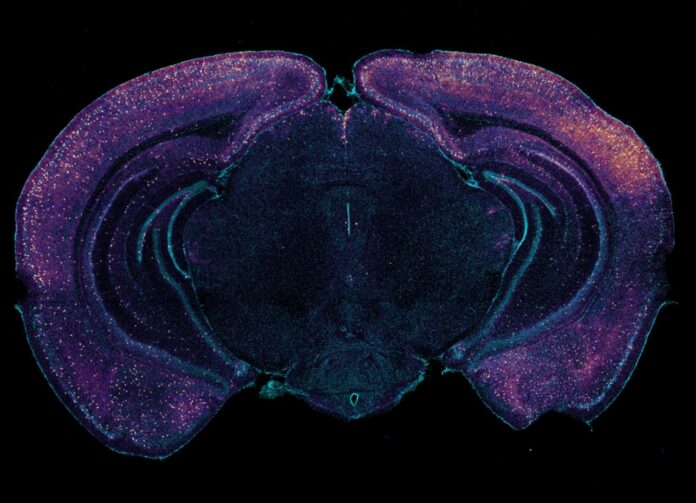The glymphatic movement is the brain’s cleansing system. To maintain the health of the brain, it eliminates waste. Researchers discovered that in mice with Alzheimer’s disease, brain stimulation at a rate of 40 times per second can help lessen symptoms.
In a recent study, researchers from MIT investigated how a certain treatment could benefit mice with Alzheimer’s disease. They found that this technique aids in the removal of amyloid proteins from the brain, which play a major role in the pathogenicity of Alzheimer’s disease. The technique uses the brain’s glymphatic system, which functions in conjunction with the blood arteries in the brain like a plumbing network.
Study senior author Li-Huei Tsai, Picower Professor of Neuroscience and director of The Picower Institute for Learning and Memory of and MIT‘s Aging Brain Initiative, said, “Ever since we published our first results in 2016, people have asked me how it works. Why 40Hz? Why not some other frequency? We have worked hard in the lab to address these fundamental questions.”
The new paper details a series of experiments performed under the direction of Mitch Murdock, PhD ’23, while he was a doctoral student at MIT studying the brain and cognitive sciences. These experiments demonstrate that a specific type of neuron releases peptides when sensory gamma stimulation increases 40Hz power and synchrony in mice’s brains.
The study’s findings imply that such brief protein signals trigger specific actions encouraging the glymphatic system to facilitate enhanced amyloid clearance.
Murdock said, “We do not yet have a linear map of the exact sequence of events. But the findings in our experiments support this clearance pathway through the major glymphatic routes.”
The team’s leaders, Tsai and Murdock, came up with a concept. They reasoned that the reduction of amyloid levels in Alzheimer’s mice by gamma-wave brain stimulation may be explained by the glymphatic system, which plays a role in clearing waste products from the brain and is influenced by brain rhythms.
They used mice that exhibited signs of Alzheimer’s disease to test this theory. First, they verified that, as previously observed, activating the brain with 40 Hz waves lowered amyloid levels. Then, they looked at whether the stimulation impacted the glymphatic system’s fluids, aiding the brain’s waste removal.
The team’s leaders, Tsai and Murdock, came up with a concept. They reasoned that the reduction of amyloid levels in Alzheimer’s mice by gamma-wave brain stimulation may be explained by the glymphatic system, which plays a role in clearing waste products from the brain and is influenced by brain rhythms.
They used mice that exhibited signs of Alzheimer’s disease to test this theory. First, they verified that, as previously observed, activating the brain with 40 Hz waves lowered amyloid levels. Then, they looked at whether the stimulation impacted the glymphatic system’s fluids, aiding the brain’s waste removal.
They discovered that activating the brain accelerated the fluid flow out of the brain and increased the amount of fluid in the brain tissue. As a result of the enlargement of the arteries draining this fluid, more amyloid was found in the lymph nodes.
They examined an astrocyte, a cell that aids in fluid exchange in the lymphatic system, to comprehend how this occurred. Gamma stimulation could no longer lower amyloid levels in these cells when a specific protein was blocked, and the mice’s performance on memory tests remained unchanged.
Gamma waves promote glymphatic flow and fluid exchange through APQ4 activation in astrocytes. They also cause surrounding blood vessels to pulse more vigorously. In several studies, mice subjected to sensory gamma stimulation showed increased arterial pulsatility compared to untreated controls.
Sequencing different cell types’ RNA and monitoring alterations in gene expression patterns is one of the most efficient new ways to track how a stimulus, like sensory gamma stimulation, affects them. Using this method, Tsai and Murdock’s group found that gamma sensory stimulation did result in changes consistent with increased AQP4 activity in astrocytes.
The RNA sequencing results demonstrated that a particular class of neurons known as “interneurons” enhanced the production of specific peptides in mice when activated with gamma waves. Among these peptides is VIP, which has been shown to protect against Alzheimer’s and aid in controlling blood flow and waste removal in the brain.
Building on this finding, the researchers discovered that mice given gamma radiation had brains with greater VIP levels. They also noted increased peptide release from interneurons that generate VIP.
The researchers ran a second experiment to see whether this rise in VIP-related peptides assisted in removing amyloid from the brain. They used chemicals to stop VIP neurons from firing. After stimulating the mice with gamma waves, they observed the typical increase in blood flow or amyloid clearance that usually happens with gamma stimulation.
This suggests that releasing VIP-related peptides triggered by gamma stimulation plays a crucial role in clearing amyloid from the brain.
“We think that many neuropeptides are involved,” Murdock says. Tsai added that a major new direction for the lab’s research will be determining what other peptides or molecular factors may be driven by sensory gamma stimulation.”
Tsai and Murdock add that while this paper focuses on an essential mechanism — glymphatic clearance of amyloid — by which sensory gamma stimulation helps the brain, it’s probably not the only underlying mechanism that matters. The clearance effects shown in this study occurred relatively rapidly. Still, weeks or months of chronic sensory gamm,a stimulation have been needed in lab experiments and arestudies to have sustained effects on cognition.
Journal Reference:
- Murdock, M.H., Yang, CY., Sun, N. et al. Multisensory gamma stimulation promotes glymphatic clearance of amyloid. Nature 627, 149–156 (2024). DOI: 10.1038/s41586-024-07132-6
